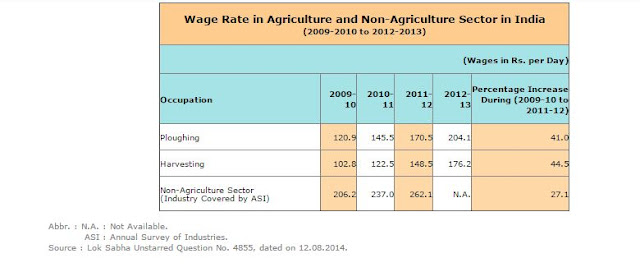Not securing the livestock: Another reason for rural agriculture distress?
In Q1 of 2019-20 financial year, agriculture, forestry, and fishing sector show the growth of 2% which is a drastic decline. The uncertainty in the prices of agricultural commodities is a known fact. But livestock is a thing which can provide the definite return to the farmer and can be a tool for poverty eradication for landless farmers and agricultural labor.
Last year I got an opportunity to conduct a survey and to interact with farmers in the tribal area. I came to know about some success stories where agricultural labor with uncertain income started earning a fixed amount per year due to livestock. There is one interesting difference between agriculture commodity marketing and livestock marketing. Unlike agricultural commodity auction where the buyer (trader) bids for prices, here as far as livestock is concerned, the seller decides the price first and then the buyer according to his/her willingness to pay, buys the animal. But still, people are reluctant to use this tool to increase their income because of the uncertainties. We have livestock insurance scheme was introduced by the Government of India in 2005- 06 to provide insurance to ‘cattle rearers’ while Sheep Insurance Scheme was introduced by the Government of India in the 11th plan. In 2014, the center started implementing the insurance scheme for all animals where subsidy will be provided on insurance premium for five animal per beneficiary.
Maharashtra Livestock Development Board
Now let’s highlight some points (terms and conditions) in the agreement.
Settlement process: Immediate intimation from policy holder to insurer on Telephone to toll-free number/ SMS/ E-mail is must, followed by a written letter. The livestock owner is advised to preserve the proof of intimation, in order to avoid further possible disputes. The carcass will be kept for verification by the animal owner up to 24 hrs from the time of death. For this, a toll-free number and a mobile number for SMS & an e-mail id should be made available which shall be mentioned in the policy.
The documents for claim settlement will include:
First information report about the death of an animal to be reported by the animal owner.
Insurance policy.
Claim form duly filled in.
Post Mortem Report with intact ear tag along with intact ear piece.
ECS Mandate form
The insurer will submit a monthly claim report in the prescribed format given by MLDB with a copy to concerned District Deputy Commissioner of AH, which is mandatory. In the case where investigation of the claim is required, it will be done within 7 days of the receipt of documents from animal owner by the Insurance Company. If the death of an animal is reported within 48 hrs., but the documents are submitted late due to genuine & legal difficulties and which is confirmed by the Govt. Veterinarian then the claim will not be denied on the grounds of delay in submission by the animal owner. Also, if Govt. veterinarian is not available, private graduate veterinary practitioner having valid registration certificate as per IVC Act 1984 shall be entitled to issuing Health Certificate and/or Post Mortem certificate.
(From AGREEMENT FOR PROVISION OF LIVESTOCK INSURANCE SERVICES MAHARASHTRA LIVESTOCK DEVELOPMENT BOARD, AKOLA (MLDB)).
This document also highlights the importance of Veterinarian. The veterinarian is responsible for physical examination of the animals and market price determination and certification, postmortem examination and documentation.
Now let’s have a look over veterinary services in Maharashtra.
In Maharashtra, there are 4856 veterinary dispensaries. (33 District Veterinary Polyclinics, 168 Taluka Veterinary Mini Polyclinics, 1740 Veterinary Dispensary Grade I, 65 Mobile Veterinary, 2841 Veterinary Dispensary Grade II).
(According to Performance Budget, Agriculture, Animal Husbandry, Dairy Development and Fisheries Department, Maharashtra).
According to the 19Th Livestock Census 2012, in Maharashtra, the total livestock population was 32489000 that means 32489000/4856= 6690 animals per dispensaries.
19th Livestock Census 2012.
Here is a problem. There is no proper availability of veterinary services. And that’s why veterinarian is not simply available who plays a very important role in the whole insurance scheme. The farmers also complaints about this inefficiency and in many cases such inefficiency becomes the main reason for not getting the amount of the insurance. NIPFP reports find that the claim ratio (Claim to Premium ratio) In Livestock Insurance Scheme, was about 0.6 in the period 2006-07 to 2009-10.
But the most serious thing is that how many animals are we covering under the scheme?
I filed RTI to Animal Husbandry, Dairy Development, and Fisheries Department, Maharashtra. And it was shocking. 508 Pack animals (Camels, Yak, Horse Donkey etc), 12603 Milch animal (Cattle and buffaloes) and 11653 other animals (Rabbit, Goat, Pig, Sheep etc) i.e. total 24764 animals in Maharashtra are secured under the insurance scheme during October 2018 to August 2019. This number is not at all impressive. Even if we assume that one family owns each cattle, then also only 12603 families who are dependent on the milch animal are secured. RTI also informs that Government has utilized 18000000 rupees against the premium subsidy. But according to Performance budget 2018-19, actual estimates for livestock insurance in 2017-18 is 26672000 Rs while budget estimates for 2018-19 are 33571000 Rs and for 2019-2020 is 31821000 Rs. It’s clear that government spending is less i.e. lesser than 2017-18’s spending.
The livestock plays important role as far as rural income is concerned, therefore if the government is interested in increasing the rural income, livestock can’t be ignored. For proper implementation, veterinary services must be improved as they are a key factor in the whole mechanism.





टिप्पण्या
टिप्पणी पोस्ट करा